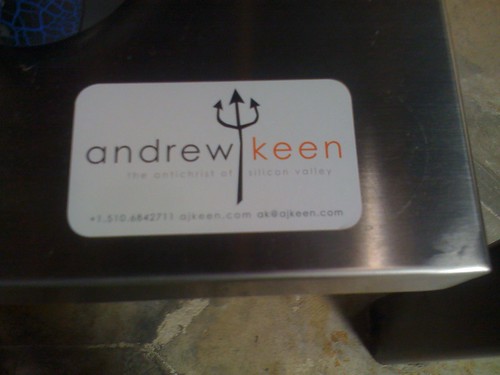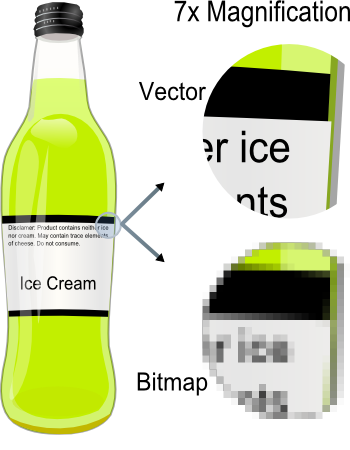Monday, December 8, 2008
FINAL REVIEW
Wednesday, December 3, 2008
More on Andrew Keen: Cult of the Amateur

Silicon Valley insider and pundit Andrew Keen claims that today's new participatory Web 2.0 threatens our values, economy, and ultimately the very innovation and creativity that forms the fabric of American achievement. In today's self-broadcasting culture, where amateurism is celebrated and anyone with an opinion, however ill-informed, can publish a blog, post a video on YouTube, or change an entry on Wikipedia, the distinction between trained expert and uninformed amateur becomes blurred.
When bloggers and videographers, unconstrained by professional standards or editorial filters, can manipulate public opinion, truth becomes a commodity to be bought, sold, packaged, and reinvented.
The anonymity that Web 2.0 offers calls into question the reliability of the information we receive and creates an environment in which sexual predators and identity thieves can roam free. Keen urges us to consider the consequences of supporting a culture that endorses plagiarism and piracy and weakens traditional media and creative institutions.
Author Andrew Keen discusses his book "The Cult of the Amateur: How Today's Internet Is Killing Our Culture" as part of the Authors@Google series. This event took place June 5, 2007 at Google Headquarters in Mountain View, CA.
Authors@Google: Andrew Keen
for Monday Dec. 8th Please bring in an example from the news/media that you would consider for the most part to be "factual" information. (non-fluff or entertainment). This can be any article you feel is "news-worthy"Monday, December 1, 2008
The Day Music Died [part two]

1. class evaluations...
2. open text Blog entry about "the way music died [side b]"....answer the questions about the reading in the form of a blog entry. (you can use the handout, and wikipedia, or other internet sources as a reference)
link to questions (also passed out in class)
3. If time permits we will start to watch excerpts from "CHOICE 2008" about pres. elect obama-->
_________________________________________________________________
1. A New Comer that steals the show 8:54
Illinois State Senator Barack Obama's life changes overnight after he delivers an electrifying speech at the July '04 Democratic Convention.
2. The Path to the corridors of power 15:38
As a community organizer in Chicago and then as president of the Harvard Law Review, Obama learns about coalition building, hones his political talents.
3. 12 year political assent 16:20
Obama learned how to play hardball, build coalitions, find mentors, seize opportunities. In '07, he starts his run for the presidency.
4. Hilary and the Primaries 8:18
He had to mobilize coalitions, test whether whites would vote for a black, and confront a formidable obstacle -- Hillary Clinton.
5. Last Laps of the Primary Campaign 9:44
Obama deals head-on with the Rev. Wright issue by delivering a speech on race relations. McCain works to unite his party and gets a key endorsement.
6. The Chicago School 3:53
Since he first ran for public office in 1996, Barack Obama has lost only one election -- to former Black Panther Bobby Rush, a popular incumbent who beat the pants off him in a Chicago congressional race. Ever the quick study, Obama learned valuable lessons about coalition-building, picked himself up, and never looked back. The rest is, well, you know what the rest is.
Monday, November 24, 2008
Special Thanksgiving Topic: The Day/Way Music Died

THE WAY (OR DAY MUSIC DIED)
1. Questions about Flash animations?
2. Overview of Andrew Keen's The Cult of the Amateur
3. Music as the Toy at the Bottom of the Cornflakes Box
4. view 2004's "The Way Music Died"
"It's a classic example of art and commerce colliding and nobody wins," says Nic Harcourt, music director at Los Angeles's KCRW-FM. "It's just a train wreck."
In "The Way the Music Died," FRONTLINE follows the trajectory of the recording industry from its post-Woodstock heyday in the 1970s and 1980s to what one observer describes as a "hysteria" of mass layoffs and bankruptcy in 2004.
5. Reading Due December 1st From Cult of the Amateur- The Day Music Died [side b]
Wednesday, November 19, 2008
Creating a New Online Youth Culture / Turn in Flash Animations

The PBS Frontline documentary, Growing Up Online, is an exploration of the digital world that kids are spending a lot of time in these days. Frontline may tend to put a hard spin issues like this, but this one was SCARY... And I'm not even a parent! If this is not a fair depiction of American youth at present, one can easily imagine it in the near future. Educators take various worthy positions on the form media education should take into schools -- teach about media without technology, teach about media through collaborative production (wink), etc. Whatever position you take, it is clear, evidenced by videos like this, that emerging digital technologies impact kids' identity formation and what it means to be a citizen in our culture, and the it is the responsibility of schools to adapt to that influence one way or another.
- from The Media Spot
1. If you haven't turned in your Flash Animations, then you can quietly work on them during this video. I can help those who need it.
2. Watch Growing Up Online
3. Blog Entry for 11/24:
- Write an analysis of "Growing Up Online"
- some ideas could include:
- Analyzing how advertising is enmeshed and personalized on MySpace
- You could also Investigate the terms target audience, datamining and advergame and make connections to other social networking sites
Monday, November 17, 2008
FLASH WORKSHOP II
2. You will have today's class to finish your animations and publish your files.
3. name your finished file like this ( yourname_com155.swf )
I will be available in class today to answer any questions, and collect your .swf files when finished.
Wednesday, November 12, 2008
Flash Workshop
Using your an example of a media article concerning unequal power relationships between men and women, social classes or different ethnic groups create a flash animation that illustrates the following:
- Is there more than one kind of ideological position/perspective evident within the media content?
2. Today you will show me the article, and start to create your animations
3. .fla files should be finished by mon. the 17th
4. .swf files can be turned in on wed. 19th
Monday, November 10, 2008
Intro to Flash CS3 / Chapter 5: Media Ideology

Important concepts in Flash:
FLASH STAGE: The stage, the large white area in the center of the screen is where the action happens. For our purposes, If it isn't on the stage, the user isn't going to see it.
TOOLS: Allow you to draw, color, and otherwise manipulate objects on the stage
TIMELINE: a place where action occurs, the timeline is broken into a series of frames. You can think of these as individual frames of a film. When you put something on the stage, it will appear in a frame. If you want to move it from one place to another it will start in one frame and end in another a little further down the timeline. The red box you see in frame one of the timeline is called the playhead
PLAYHEAD: this shows you the current frame being displayed. When a Flash movie is playing through a browser, the playhead is in motion and the user is seeing the frame where the playhead is located
PANELS: These are used to modify and manipulate whatever object you may have selected on the stage or even to add an object to the stage (library)
PROPERTIES PANEL: When an object is placed on the stage and selected using the selection arrows in the tools panel, the properties inspector panel will change to reflect the properties of that object that can be manipulated. Such as, stroke, fill, size/scaling, you can also add motion tweens here
flash tweening explained
In class:
1. learn to set up a flash document
2. learn to draw a shape, and convert it to a symbol
3. learn to import to the library
4. Create a simple motion tween using keyframes and/or a motion guide layer
For Next Class 11/12 Wed.
1. Read 150-157
2. Find an example of media coverage concerning unequal power relationships between men and women, social classes or different ethnic groups
- Is there more than one kind of ideological position/perspective evident within the media content?
4. Bring a copy of the article, and the images ready to animate for next class
Wednesday, November 5, 2008
Do campain producers give us what we want?

“Political advertising ... is just the artful assembling of nominal facts into hideous, outrageous lies.”
Bob Garfield, Columnist, Advertising Age
Campaign 2008 broken all records for advertising dollars spent in a single election -- no picnic for the bombarded electorate, but a bonanza for the industry that does the bombarding.
So who are these marketing wizards, and how do they decide what works and what doesn't? For answers, we nominate this excerpt from The Persuaders, a 2004 FRONTLINE classic that looks at the sophisticated niche marketing tools advertisers use to customize messages for particular constituencies.
In the excerpt, correspondent and media critic Douglas Rushkoff visits with Republican political consultant Frank Luntz, a venerable practitioner of the persuasive arts and a master at telling people what his research says they want to hear.
For Mon 10th Have a blog entry created answering the following questions:
1. Where are we headed? What's the future? What are your thoughts on how far the techniques of persuasion might go?
Monday, November 3, 2008
PBS FRONTLINE: The Merchants of Cool
 The Merchants of Cool - PBS FRONTLINE REPORT
The Merchants of Cool - PBS FRONTLINE REPORTThey spend their days sifting through reams of market research data. They conduct endless surveys and focus groups. They comb the streets, the schools, and the malls, hot on the trail of the "next big thing" that will snare the attention of their prey--a market segment worth an estimated $150 billion a year.
They are the merchants of cool: creators and sellers of popular culture who have made teenagers the hottest consumer demographic in America. But are they simply reflecting teen desires or have they begun to manufacture those desires in a bid to secure this lucrative market? And have they gone too far in their attempts to reach the hearts--and wallets--of America's youth?
FRONTLINE correspondent Douglas Rushkoff examines the tactics, techniques, and cultural ramifications of these marketing moguls in "The Merchants of Cool." Produced by Barak Goodman and Rachel Dretzin, the program talks with top marketers, media executives and cultural/media critics, and explores the symbiotic relationship between the media and today's teens, as each looks to the other for their identity.
DUE WED. November 5th BLOG ENTRY:
![]()
What are your opinions on the tactics and techniques of the marketing media who are targeting teenagers? Have they gone too far?
Wednesday, October 29, 2008
10-29 Quiz & How do Media Professionals KNOW the audience?
2. From your reading on p. 120-130 create a blog entry that answers the question:
How Do media professionals "Know" their audiences?
The era of media globalization poses new questions about the relationship(s) between media professionals and media audiences. Other than ratings or sales figures, or perhaps audience response through email or tv on demand, how do media professionals who produce globally distributed media texts gauge audience interest and response to their media?
You may use the book and the web as a resource.
3.Next time read 131-148 (finish chapter 4) we will discuss and relate back to the ideas presented in PBS's "The merchants of Cool"
Monday, October 27, 2008
$$$Money as Debt$$$ 10-27
 10/27
10/271. Make sure you have turned in your Animation Projects to me
2. watch MONEY AS DEBT by Paul Grignon
producer's notes:
3.Create a short analysis of "Money as Debt" as a blog entry (by 10/29)Money created as interest-bearing bank credit is a magic trick, a fraud - now 3 centuries old; one that very few people have seen through despite, or rather because of, its utter simplicity.
It is my intention to make this mysterious debt-money system comprehensible to everyone. It is also my intention to foster sufficient understanding of the problems with this money system that citizens will be motivated to join the monetary reform movement and/or create local alternatives to the global monetary system - a system in which most of the productive people of the world are collectively chained to an ever-increasing and perpetually unpayable debt.
This is a system designed for elite control of the people by those who have given themselves the privilege of creating money. It is also, I believe, a system that is designed for catastrophe. As the movie explains, there can be no sustainable civilization without a sustainable money system
4. for 10/29 read 120-130
5. Also Get ready for a short quiz next week on file formats (.ai, .psd, .jpg, .gif) bitmaps vs. vectors, and photoshop vs. illustrator (10-29)
Wednesday, October 22, 2008
10-22 Animation Studio
2. upload one of the frames as a still to your blog with an new blog entry thoroughly explaining and describing of your choice of imagery and animation.
3. Hand in the actual animated .gif to by the end of class to me on my USB drive
4. For next Monday the 27th Have all of Chapter 3 finished
5. Get ready for a short quiz next week on file formats (.ai, .psd, .jpg, .gif) bitmaps vs. vectors, and photoshop vs. illustrator (10-29)
Monday, October 20, 2008
CONGLOMERATION ANIMATION 10-20

1. intro to animation window in photoshop ( watch video tutorial )
2. review of layers
3. class example of animation using FRAMES and LAYERs
4. explanation of Motion Tweening
5.Review of .gif vs .jpg (vs vetors)
READING P88-100 DUE 10-22
ASSIGNMENT DUE WED. 10-22 (YOU WILL HAVE STUDIO TIME TODAY AND WED. TO WORK ON THIS PROJECT)
Create a Media Conglomeration Animation
create an animated .gif that visually represents The ownership and control of the mainstream media.
You can use an example of a media conglomerate from the first 3 chapters of the book such as (News Corp, Viacom, time warner, General Electric, etc.)
Using logos, imagery, and movement try to simply show how increasingly powerful the role of media conglomerates are in the global media industry.
start with a new photoshop doc @ 72dpi, 800 x 600
Wednesday, October 15, 2008
10-15 Illustrator Studio
2. Save your Illustrator project as a .jpg using "save for web" out of Illustrator
3. Post your final image (large format on blogspot) along with the original image you worked from, with a short blog entry about the project.
4. Have a good Mid-Semester Break
Monday, October 13, 2008
10-13 BITMAP VS. VECTOR GRAPHICS

1. examine the difference between pixel based and vector based graphics.
2. look at illustrator basic vector shapes, type tool, fill, stroke, group arrange and Place functions
3. Look at BLO Billboard liberation Front
4. Vector Magazine Cover / Advert re-do or Parody in Adobe Illustrator (example magazine cover)
5. For 10-15 Read p. 87 - 94 and Have Basic Layout Done
Wednesday, October 8, 2008
10-8-2008 FINISHING CHAPTER 2
create an in-class blog entry with the following:
a. Chapter 2 describes six key aspects of media globalization. Using your own words and examples from the mass media elaborate and and explain how 3 of these 6 main features effect us on a global level.
b. Follow your argument by explaining some of the concerns and worries relating to media globalization as described in the book. Elaborate on whether or not you believe this type of criticism to be valid.
c. Illustrate your entry with a .jpg
2. STUDIO TUTORIAL- BITMAP VS. VECTOR GRAPHICS, CONVERTING BITMAPS TO VECTORS IN FLASH
Monday, October 6, 2008
10-06 Media Globalization and Resistance
Wednesday, October 1, 2008
Reading for 10-6
Monday, September 29, 2008
Media Globalization Remix Exercise due 10-1-08

1. Start by selecting a new media example, theme, or technology
2. Using Photoshop create a collage of imagery that visually represents an example of media globalization and information overload the world is currently experiencing.
3.Take into account:
Media ownership
Technologies
Production
Content
Reception
4. Start with a new Photoshop Document sized at 800 x 600 pixels at 72dpi
5. Use the lasso, polygonal lasso, magnetic lasso, selection tools, layers and opacity to cut, paste, visually remix, mash and layer your media collage.
6. Post the image to your blog (large format) with an explanation of your choice of imagery, also saving your original 800 x 600 .jpg
7. Read Pages 42-49 in textbook
Wednesday, September 24, 2008
9-24-08 Media Globalization Entry

DUE SEPT. 29th
1. The book described The Simpsons as a classic example of the Globalization the media.
2. Pick your own media example from popular culture TO create a blog entry that examines the example in a social context describing media globalization
2. Place a visual example of your media example with the blog entry. (cropped image(.jpg))
3. MAKE SURE YOU HAVE CHAPTER ONE THOROUGHLY READ
Monday, September 22, 2008
9-22-2008 U2 & the Record Industry
1. Apply 2 questions of your choice from the 'Asking questions about U2' section starting on page 18 of the text to a popular/mainstream female recording artist.
2. Create a posting on your Blog with a cropped image (.jpg) of the artist above your thoughts on the 2 questions.
3. Have pages 19-33 read
